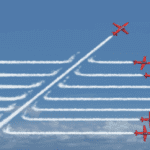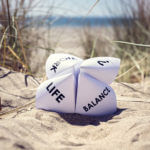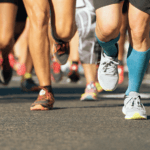Practice could save your life...literally

As a thought leader and speaker, I travel every month. So I was shaken by the news of the tragedy on Southwest flight 1380. I write and speak about the brain science of success and I was struck by how many elements of learning were at the heart of this scary experience.
Several flight attendants have spoken out about this photo above, stating that it shows most of the people wearing their masks incorrectly despite the fact that the mandated demonstration occurred just minutes prior. So what happened?
It's true that observational learning matters. The reason flight attendants stand in front of us with a real oxygen mask and show us how to put one on is that it's a vital part of how we learn. Our brains learn by watching others because of something called the mirror neuron system. When we observe someone else doing a behavior, the same neurons fire in our own body. Many of us know that seeing someone do a behavior correctly helps us learn how to do it too. Except, there are 2 critical caveats.
First, to learn any behavior, we actually have to be paying attention. Focused attention. While we have seen and heard this presentation numerous times, how many of us really give the flight attendant our undivided attention? Not many. I'm guilty of this too. We use those minutes to settle into our seat, fire off one last text, or starting queuing up our movie. But the truth is that the human brain cannot learn effectively when we are multitasking. Learning something, so that it is retained in your memory and actually impacts your behavior, requires focused attention.
I know that the first few times I flew in a plane (which I did not do until my 20s), I was very focused on the attendant. Everything was new and somewhat overwhelming so I read the safety card and watch the demonstrations closely.
And then I flew again. And again. And again. And that's when complacency sets in. Did you know that complacency is the biggest contributor to accidents and injuries around the world? People of all ages and in all kinds of careers get used to doing something successfully. Like doctors performing a surgery, or welders fixing a metal part, or accountants completing a tax return. When we successfully complete a potentially dangerous activity, for example driving a car, our brain reduces the perceived risk. At first, we are mindful of the dangers and pay extra attention. But after numerous repetitions, we start to believe that it's not going to happen or that we already know what to do. Complacency is something we have to actively counterbalance.
Second, the fight/flight/freeze response actually takes a large portion of your brain offline. This is the thing that none of us can really anticipate. Like most people, I can probably recite the flight attendants spiel by heart. "In the event of cabin depressurization, an oxygen mask will drop down. Grab the mask and place it over your nose and mouth and then tighten the straps. Don't worry if the bag does not inflate. Oxygen will be flowing so just breathe normally." I literally typed that from memory—I did not look it up.
So like the passengers on flight 1380, I would have told you that I know what to do—that I know how to put on the mask. But the problem is that when disaster strikes, our brain kicks off the fight/flight/freeze response and floods our bodies with adrenaline and cortisol. What most people don't realize or anticipate is that when this happens, the neocortex layer of our brain, where analytical thinking happens, goes OFFLINE. We literally lose our ability to think things through or figure things out. One UCLA neuroscientist estimates that we lose at least 25% of our intelligence, perhaps even more, when we are under duress. This is why all kinds of personnel are taught to communicate in a specific way during an emergency. Use simple commands. State them very loudly. Repeat them over and over.
A few years ago, I was home when out of the blue, a sheriff pounded on our door around 9 pm at night. We were told there was a situation on the hill above us that could threaten our home and we had 15 minutes to evacuate. I was startled and shaken as I started wandering around the house. Do you know what I did? I brushed my teeth! I used up precious minutes because I couldn't think of what to do. So I defaulted to a habit, something I do every day before I leave the house.
This brings us to the power of practice. Practice is how we build the neural pathway of any behavior. Did you know it takes on average 40-50 repetitions of a behavior to form a habit? I have brushed my teeth thousands of times but I had never evacuated before. While we have watched an oxygen mask being put on hundreds of times, how many times have we actually put one on? For most of us, the answer is zero.
But what if you made yourself practice? Even with an invisible or pretend oxygen mask, you could practice the motions we see the attendant demonstrate. Try that now. Pretend the mask has dropped down. Picture what the attendant does and then do it with your hands. Try fitting the mask over your nose and mouth. Put the strap over your head and tighten the ends. Breathe. If you did that 40-50 more times, your body would know what to do, even if you're in a panic.
This very tactic saved the lives of thousands of people during 911. Consider the story of Rick Rescorla, a security guard who worked for Morgan Stanley at the World Trade Center in New York. After the WTC was bombed in 1993, Rescorla was upset about how disorganized the evacuation had been and he also worried that future attacks were likely given the iconic nature of the buildings. As a result, he insisted that all 2,700 employees, including senior executives, regularly practice evacuating from their offices, which occupied twenty-two floors of the South Tower. He would grab a bullhorn, and despite complaints from employees who wanted to focus on their work, he would have them practice taking the stairs down.
He didn’t just do this once or twice. He made them practice every three months. So when the unthinkable happened on September 11, 2001, and the first plane hit the North Tower, the 2,687 employees who were at work that day knew exactly what to do—because they had already done it 32 times. Despite the terror and confusion, their practice kicked in and those survivors credit Rescorla with saving them.
But what if we don't have a Rick in our lives? Well, first, we can value the power of practice and do it with intentionality. Miming the action works, even if you don't have access to a real oxygen mask. Research shows that even visualizing a behavior with great focus and detail can develop neural pathways and habits. Role plays, scenarios, and simulations work because we mimic a real-life situation and then practice what to do.
Virtual reality (VR) can also play a vital role. VR scenarios are so realistic that our brain codes them as a real, lived experiences and even stores them as memories. We can build real and sustained behaviors by doing them in a virtual setting. This includes actions, like putting on a mask, as well as emotions, like staying calm in the face of chaos or responding appropriately to the unexpected. What if we could practice things that would save our lives, not just on planes but anywhere? Do you know how to save someone who is choking? To use a defibrillator? To gain control of a skidding car? VR has the ability to give us all easy access to powerful learning experiences with not only physical skills but emotional ones too, like empathy and calmness.
Pilots have been using this strategy for decades, logging hours in flight simulators, just so they can practice responding to all kinds of scenarios. They groove the habits that allow them to know what to do for a range of possible scenarios as well as prepare them to remain cool and focused when something completely unanticipated happens.
This was certainly true for Southwest pilot Tammie Jo Shults who landed the badly damaged plane, saving the lives of all but one passenger who was fatally injured when the engine exploded. Shults is a Navy veteran and was one of the first female fighter pilots. She drew on all of her experiences, both real and simulated, to make the right decisions and take the best actions in the extreme chaos of the disaster. She is a hero.
I'm traveling again in a couple weeks and I realize I need to prepare more than just my speech and my suitcase. I need to do my part in keeping myself and others safe. So I'm going to put on my imaginary mask 50 times between now and May 1st. While I hope I'm never in the situation where I need to do it correctly, it certainly seems like a good use of my time especially given how much I fly. What is a behavior that would make your life safer or better?
Perhaps it's something at work like being better at collaboration or managing. Maybe it's something at home like extending empathy or compassion to your spouse or child. It could be something for your health like exercising or meditating. Whatever it is, give it your focused attention and practice intentionally. The only way we get better at anything is through practice. Set a goal of 40-50 repetitions and by the time you get there, you will be not only better at that skill but it will become something you can count on, even under duress.
Related Blogs
JOIN OUR COMMUNITY
Be the first to know of Dr. Britt Andreatta's latest news and research.





